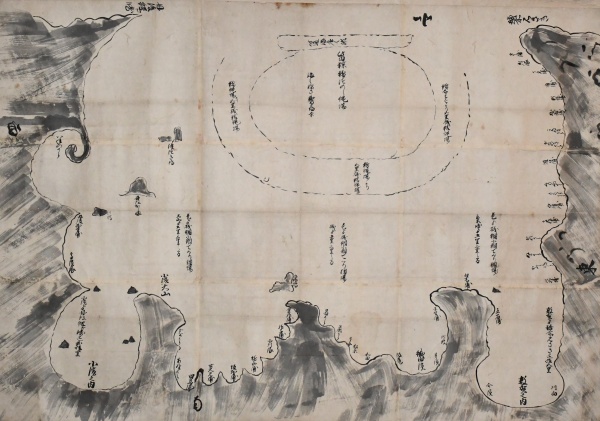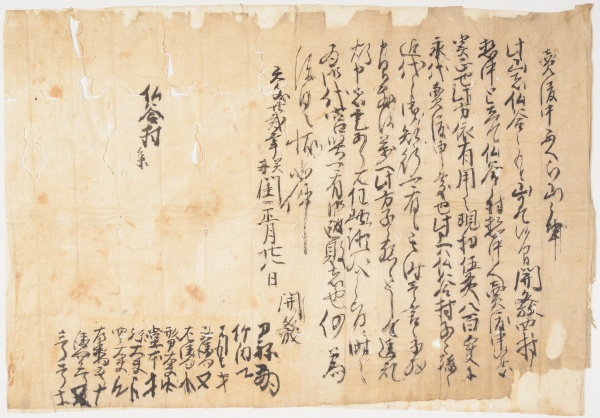Basic Joint Research Project: Study Utilizing Hand-Copied Texts, Historical Documents, and Drawings Held by the Institute for the Study of Japanese Folk Culture to Examine Disputes, Interaction, and Trade in Seaside/Mountain/Farming Villages along the Wakasa Bay Coast and its Vicinity
This joint research project was accepted through an FY2023 open recruitment for joint studies involving the use of museum collections.
Geographical Scope
Sea, mountain, and farming villages in the Wakasa Bay coastal area as well as the regions of shared interaction and trade
Purpose
-
 1665: Wakasa Bay Fishing Chart (Mihama Town, Fukui Prefecture, Watanabe Rokuroemon-ke Monjo [Watanabe Rokuroemon Family Documents])
1665: Wakasa Bay Fishing Chart (Mihama Town, Fukui Prefecture, Watanabe Rokuroemon-ke Monjo [Watanabe Rokuroemon Family Documents])
-
 January 28, 1553: Certificate of Mountain Sale Signed by Tone and Others of Hotokedani-mura Village (Hotokedani, Obama City, Fukui Prefecture, Ohashi Wakizaemon-ke Monjo [Ohashi Wakizaemon Family Documents])
January 28, 1553: Certificate of Mountain Sale Signed by Tone and Others of Hotokedani-mura Village (Hotokedani, Obama City, Fukui Prefecture, Ohashi Wakizaemon-ke Monjo [Ohashi Wakizaemon Family Documents])
This study aims to elucidate the characteristics of coastal villages with complex occupations and the nature of the trade, interactions, and disputes with nearby mountain and farming villages and regional cities that supported these occupations and life in general, using the Wakasa Bay Coast as a reference. This region is important as a commodity supply area for the major cities of Kyoto and Nara. Moreover, several hundred thousand historical documents from the Middle Ages through to the prewar modern era remain, making this region almost the only area where the regionality of occupations, environments, and village structures can be thoroughly explored, along with their relations with the surrounding regions. The researchers will also conduct field surveys while making a complete collection of the historical documents extant in the Wakasa Bay coastal region and the hand-copied texts, historical documents, and drawings held by the Institute for the Study of Japanese Folk Culture, taking an interdisciplinary approach to the clarification of the realities of the trading areas and disputes among villages connected in diverse ways, as well as the causes thereof and their processes of formation and change.
Expected Findings
The findings of the historical documents and drawings collected in this study, and of the field surveys, will be made public online in digital and catalog form, as well as being made widely available to society in collaboration with various research institutions.
[Research Period] October 2023 through March 2026
Joint Project Leaders
・ HASEGAWA Yasuko Atomi University
・ SEKIGUCHI Hiroo Institute for the Study of Japanese Folk Culture
Joint Project Members
・ HARUTA Naoki Kumamoto University
・ KOBAYASHI Kazutake Meisei University
・ NOJIRI Yasuhiro Meiji University
・ ICHIAKWA Hideyuki The University of Shiga Prefecture
・ HASHIMURA Osamu Tokyo Gakugei University
・ NAKAMURA Shingo University of Toyama
・ OKOCHI Yusuke Fukui Prefectural Museum of Cultural History
・ USAMI Rintarou Fukui Prefectural Board of Education
・ KUROTAKI Kana Hitotsubashi University Graduate School


